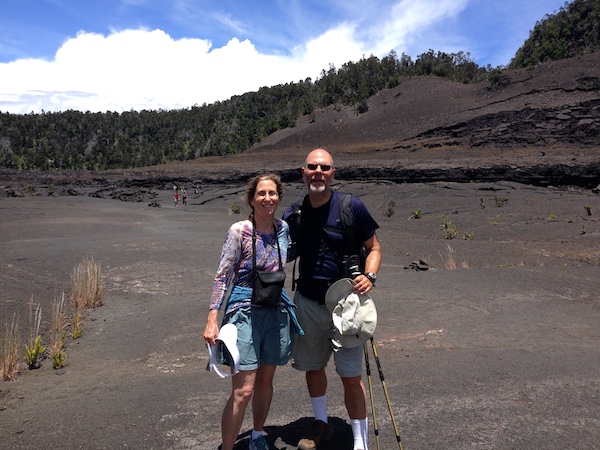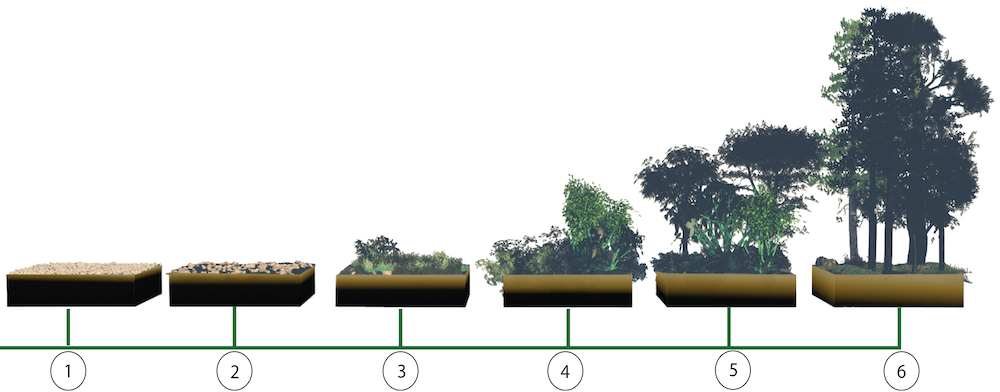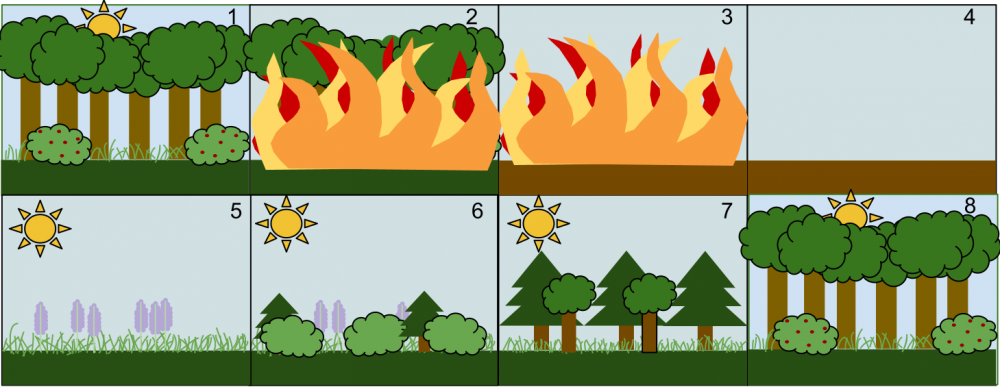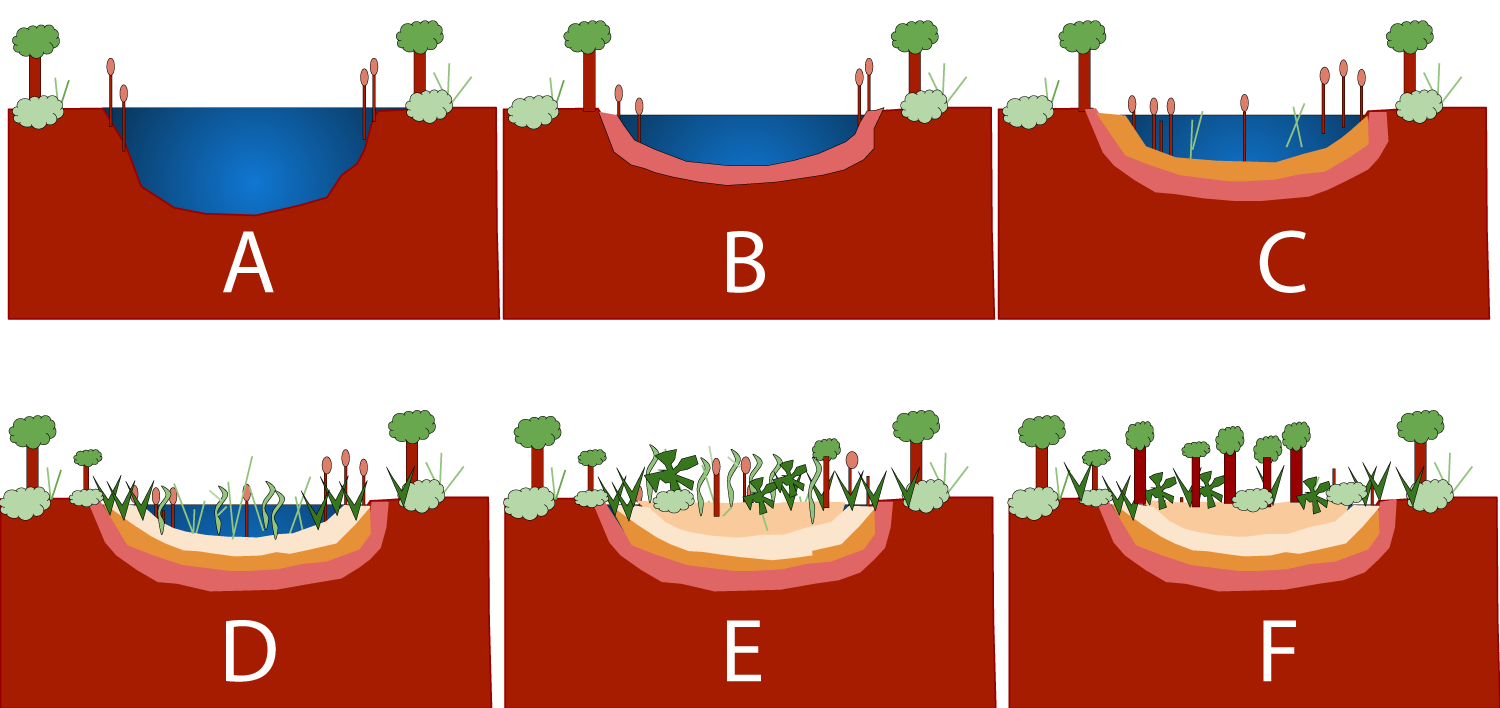Community Ecology Student Learning guide (link opens a new tab)
1. Introduction to Ecological Succession
Unlike many of the topics we’ve covered in this biology course, ecological succession is one that most of us can observe on our own, within a short distance from where we live. Think of a small patch of land near your home that’s been recently cleared. It could even be an abandoned parking lot. Depending on how long it takes for that abandoned lot to be redeveloped, you can predict the changes that will follow over the ensuing months. The pavement will start to crack. Moss will grow in those cracks. Then weeds, like dandelions, will follow. If the lot is abandoned for years, small shrubs might start to appear.
The process by which a community changes over time is called ecological succession. The term succession means “the act or process of following an order” (Merriam-Webster). Ecological succession is the “unidirectional change in the composition of an ecosystem as the available competing organisms and especially the plants respond to and modify the environment.” (Merriam-Webster).
2. Primary Succession

Primary succession refers to what happens to a community when it’s completely scraped clean, right down to bare rock or sand. Think of the lava flows that on volcanic islands, such as those in Hawaii. Or a hillside that experienced a rock slide. The key point is that the process starts in an area where there’s no soil: just rock or sand.
The changes that occur in such an area are predictable.

Stage 1 shows the bare rock with which succession begins. Whatever was in this area before, it’s been wiped away.

Stage 2 begins as pioneer species, such as lichens and mosses, start to colonize the rocks. Lichens are mutualistic symbionts that consist of photosynthetic algae, harbored within a fungal host. As the lichens grow and spread, their biomass will accumulate, starting the process of creating soil that can support other plants. Mosses are also pioneer species. Their roots secrete acids that start to break down the rocks. As the lichens and mosses spread, they initiate the process of soil creation.
In stage 3, sun-tolerant herbaceous (non-woody) plants enter the area. As more soil is created, the lichens and mosses become covered by the herbs. This is a key dynamic of succession: each plant community sets the stage for the next community. Also note that while it can’t be seen in this diagram, animal life is entering the community as well. Along with eating the plants, the animals pollinate the flowers and contribute to soil creation through their droppings.
In stage 4, the soil has accumulated to the point where shrubs with woody stems and branches can come in and replace the non-woody herbs that preceded them. The leaves that the plants shed contribute to soil creation, as do their roots, which penetrate and continue to break up the rocky substrate.
In stage 5, the sun-loving shrubs of stage 4 are replaced by trees. This creates a multi-layered forest, with a canopy of leaves and branches from the taller trees. Beneath the canopy are shade-tolerant shrubs, capable of surviving in indirect sunlight.
In stage 6, the process of succession culminates in what’s called a climax community. As opposed to setting the stage for its own replacement, a climax community perpetuates itself. An example of a climax community is the redwood forest found in coastal northern California (which was described in the introduction to this module). The trees in this forest live for hundreds of years (with some as old as two thousand years). The understory consists of shrubs like rhododendrons, salal, and huckleberry. When the individual plants die, they’re replaced by new individuals of the same species (new redwoods, hemlocks, firs, rhododendrons, etc.).
3. Secondary succession starts with intact soil
When a forest is cleared (by human activity such as logging, or by a forest fire), secondary succession follows. The main difference between primary and secondary succession is that secondary succession starts with an intact layer of soil. Soil creation is one of the most time-consuming parts of primary succession. As a result, the recovery of a forest following a fire or clearing can be much quicker than what occurs during primary succession.
The cartoon below shows secondary succession at work.

4. Pond Succession
Ponds and lakes also go through a natural process of succession. During this process, debris accumulates within the pond, making the pond increasingly shallow. The source of this debris can be the terrestrial plants along the pond’s edge or aquatic plants that live in the pond. From a clear, deep pond (A), the process leads to the development of a shallow bog (D), then a moist meadow of mostly herbaceous (non-woody) plants (E), and finally to a forest (F).

5. Key trends associated with succession
Just by looking at the diagrams above, you could probably infer the following trends associated with succession:
- Key environmental factors shift from abiotic to biotic. Just consider how in the early, rocky environment an organism is directly exposed to sunlight, heat, wind, and rain. In a climax forest, organisms still experience these elements, but they’re moderated by the structure of the forest itself: much less wind, much more moderate temperatures, less direct sunlight, etc.
- Overall biodiversity (the number of species) increases.
- Overall biomass (the amount of living matter) increases.
- Spatial complexity increases as a forest canopy and a multi-layered understory develops. Imagine a forest with a layer of shrubs growing beneath tall trees, and small non-woody wildflowers growing on the forest floor, and you’ll get the idea.
- More ecological niches and microhabitats become available. As the community ages, there are increasing numbers of species interacting in increasingly complex ways. Increased diversity among producers leads to increased diversity in animal species and decomposers.
- Opportunistic, r-selected, short-lived species are replaced by longer-lived K-selected species.
6. Ecological Succession: Checking Understanding
The quiz below will check your understanding of how succession works. Do your best, and don’t worry about getting everything right on the first try.
[qwiz style=”width: 650px !important; min-height: 400px !important;” qrecord_id=”sciencemusicvideosMeister1961-Ecological Succession: Checking Understanding”]
[h]Ecological Succession 1: Checking Understanding
[i]
[q labels = “top”]
- Throughout ecological succession, the assembly of species shifts from __ selected to ___ selected.
- _________ environmental conditions are replaced by __________ environmental conditions
- Soil mass ___________.
- Biomass ____________.
- The number of interspecific interactions ___________.
- The lifespan of organisms in the community shifts from a __________ lifespan to a __________ one.
- The community becomes _________ stable and __________ resistant to change.
- The physical structure of the community becomes more ____________.
[l]abiotic
[fx] No, that’s not correct. Please try again.
[f*] Good!
[l]biotic
[fx] No, that’s not correct. Please try again.
[f*] Excellent!
[l]complex
[fx] No, that’s not correct. Please try again.
[f*] Excellent!
[l]increases
[fx] No. Please try again.
[f*] Excellent!
[l]K
[fx] No, that’s not correct. Please try again.
[f*] Great!
[l]longer
[fx] No, that’s not correct. Please try again.
[f*] Correct!
[l]more
[fx] No, that’s not correct. Please try again.
[f*] Correct!
[l]r
[fx] No. Please try again.
[f*] Great!
[l]shorter
[fx] No. Please try again.
[f*] Great!
[q labels=”top”]The basic idea of ecological succession is that over time, the composition of a community will __________. As a community ages, each stage sets up conditions for the _________ one. This continues until a community develops into a self-_______________ __________ community.
[l]climax
[f*] Good!
[fx] No. Please try again.
[l]change
[f*] Excellent!
[fx] No. Please try again.
[l] perpetuating
[f*] Good!
[fx] No. Please try again.
[l]next
[f*] Good!
[fx] No. Please try again.
[q] The process by which the composition of a community changes over time is called ecological [hangman].
[c]IHN1Y2Nlc3Npb24=[Qq]
[f]IEdvb2Qh[Qq]
[q] In the course of ecological succession, the self-perpetuating community that arises at the end of the process is called the [hangman] community.
[c]IGNsaW1heA==[Qq]
[f]IEV4Y2VsbGVudCE=[Qq]
[q] The type of succession process that begins with rock or sand — or, in other words, without soil— is called [hangman] succession.
[c]IHByaW1hcnk=[Qq]
[f]IENvcnJlY3Qh[Qq]
[q] The diagram below represents [hangman] succession
[c]IHNlY29uZGFyeQ==[Qq]
[f]IEdvb2Qh[Qq]
[q] You can tell that the diagram below represents [hangman] succession because of the lack of [hangman] at the start of the process.
[c]IHByaW1hcnk=[Qq]
[f]IEdyZWF0IQ==[Qq]
[c]IHNvaWw=[Qq]
[f]IENvcnJlY3Qh[Qq]
[q] In the diagram below, you could expect to find pioneer species such as lichens and mosses in stage
[textentry single_char=”true”]
[c]ID I=[Qq]
[f]IEV4Y2VsbGVudC4gVGhlIGVhcmxpZXN0IGNvbG9uaXplcnMgKG1vc3NlcyBhbmQgbGljaGVucykgd291bGQgYmUgcHJlc2VudCBpbiBzdGFnZSAyLg==[Qq]
[c]IEVudGVyIHdvcmQ=[Qq]
[f]IE5vLg==[Qq]
[c]ICo=[Qq]
[f]IE5vLiBIZXJlJiM4MjE3O3MgYSBoaW50LiBTdGFnZSAxIGlzIGJhcmUgcm9jay4gV2hpY2ggc3RhZ2Ugc2hvd3MgZWFybHkgY29sb25pemVycyBsaWtlIG1vc3NlcyBhbmQgbGljaGVucyBjb21pbmcgaW4gdG8gY29sb25pemUgdGhpcyByb2NreSBhcmVhPw==[Qq]
[q] In the diagram below, stage 2 shows the arrival of [hangman] species such as mosses and lichens. Stage 6 shows a [hangman] community.
[c]IHBpb25lZXI=[Qq]
[f]IEdyZWF0IQ==[Qq]
[c]IGNsaW1heA==[Qq]
[f]IEdyZWF0IQ==[Qq]
[q] In the diagram below, which number shows the climax community? Note that two answers are possible, and you can enter either one.
[textentry single_char=”true”]
[c]ID E=[Qq]
[f]IE5pY2Ugam9iISBCb3RoIDEgYW5kIDggc2hvdyB0aGUgY2xpbWF4IGNvbW11bml0eQ==[Qq]
[c]ID g=[Qq]
[f]IE5pY2Ugam9iISBCb3RoIDEgYW5kIDggc2hvdyB0aGUgY2xpbWF4IGNvbW11bml0eQ==[Qq]
[c]IEVudGVyIHdvcmQ=[Qq]
[f]IFNvcnJ5LCB0aGF0JiM4MjE3O3Mgbm90IGNvcnJlY3Qu[Qq]
[c]ICo=[Qq]
[f]IE5vLiBIZXJlJiM4MjE3O3MgYSBoaW50LiBUaGUgY2xpbWF4IGNvbW11bml0eSBpcyB0aGUgc2VsZi1wZXJwZXR1YXRpbmcgY29tbXVuaXR5IHRoYXQgd2lsbCByZXBsYWNlIGl0c2VsZiBhbmQgcGVyc2lzdCAodW50aWwgdGhlIG5leHQgZmlyZSku[Qq]
[q]The diagram below shows the stages of pond succession, arranged randomly. Number them from earliest (1) to latest (6)
[f*] Excellent!
[fx] Sorry, that’s not correct.
[l]2
[fx] No. Please try again.
[f*] Correct!
[l]3
[fx] No. Please try again.
[f*] Excellent!
[l]4
[fx] No. Please try again.
[f*] Excellent!
[l]5
[fx] No, that’s not correct. Please try again.
[f*] Great!
[l]6
[fx] No. Please try again.
[f*] Great!
[restart]
[/qwiz]
Updated, for sync, 8/10/20
Links
- Biodiversity (the next tutorial in Community Ecology)
- Community Ecology Main Menu
